Question
C++ Project: It needs to be done in c++ as soon as possible. It's urgent. I'll surely give you thumbs up and reviews if u
C++ Project: It needs to be done in c++ as soon as possible. It's urgent. I'll surely give you thumbs up and reviews if u do it correctly according to the requirements.
There is something that needs to be done in the project, I want to tell you. When receiving input, you need to receive it as follows. Because the test operations will be done with different files.
main(int argc, char* argv[]) you get it, when you run it from terminal ./main file1.txt file2.txt When you type, the argv array is filled with these strings: {"main", "file1.txt", "file2.txt"} You can access them by typing argv[1] or argv[2] in main.
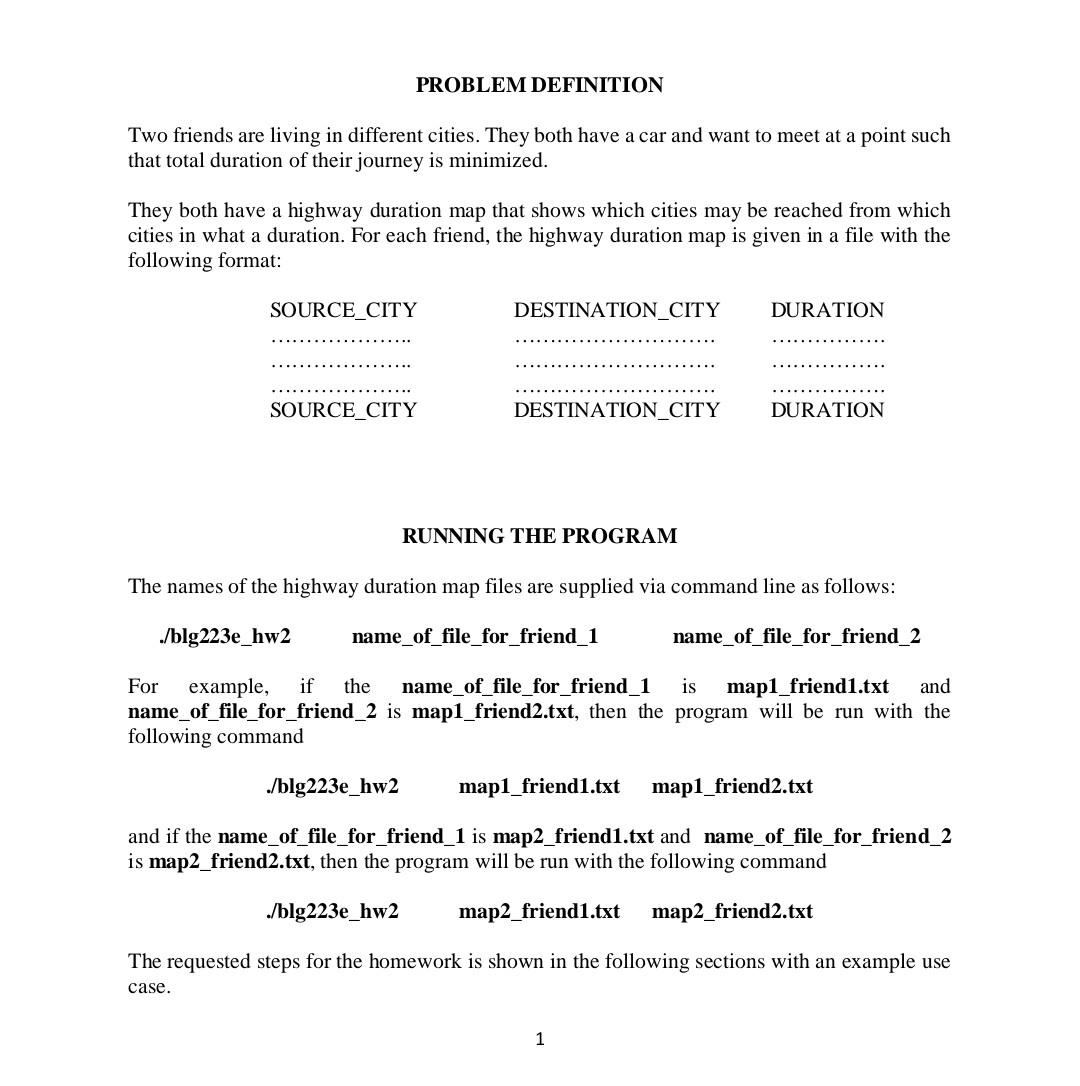
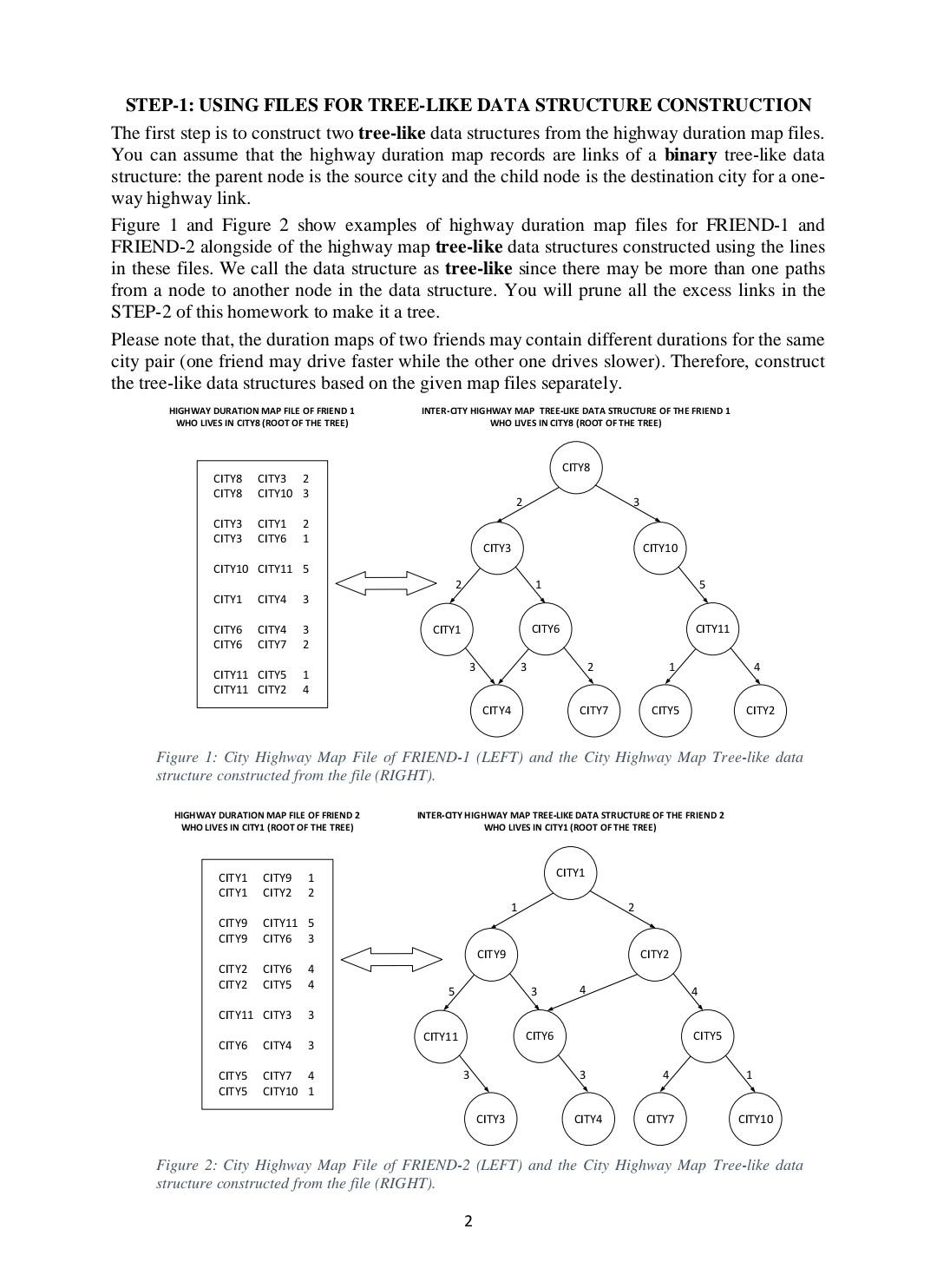
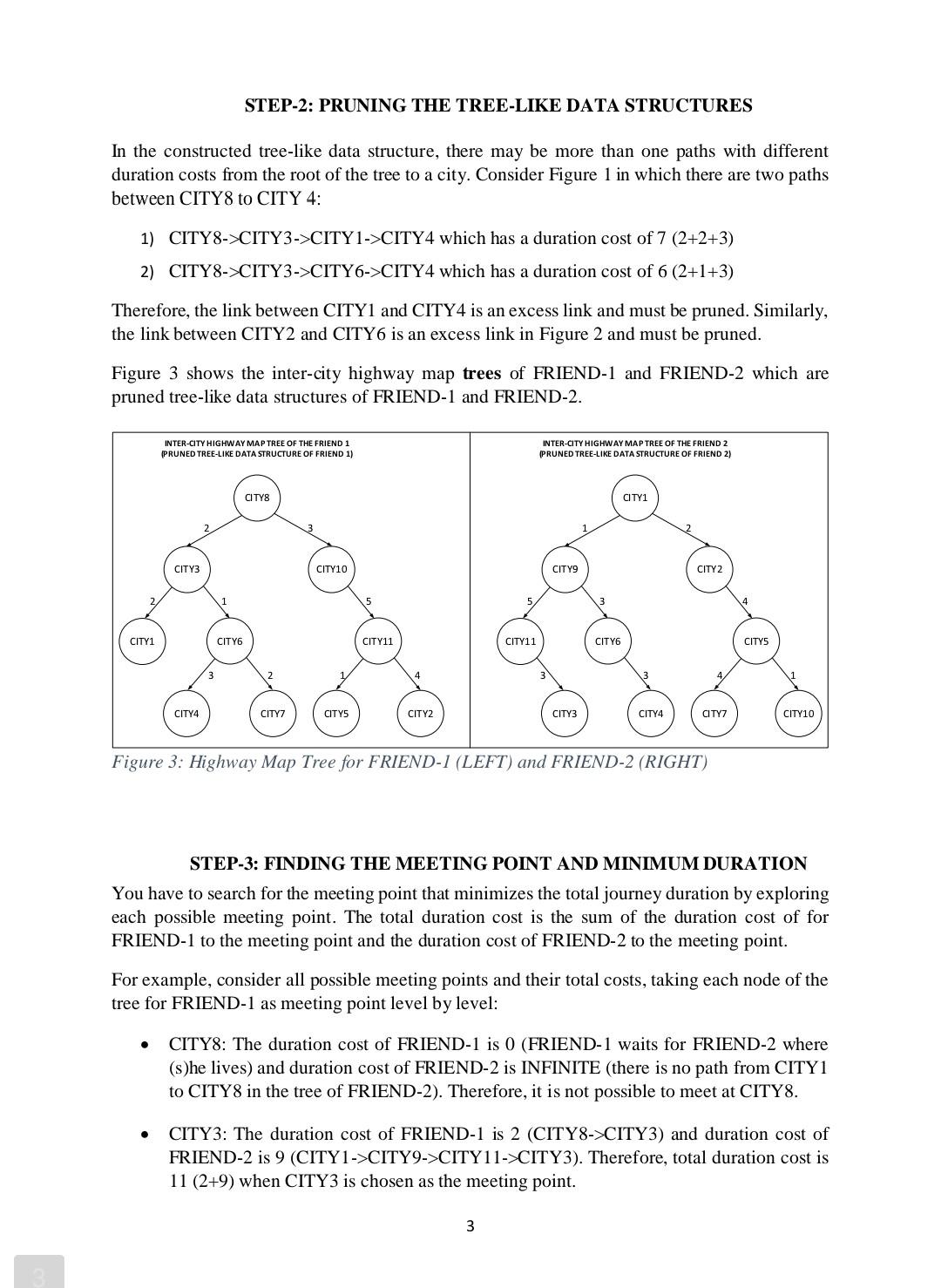
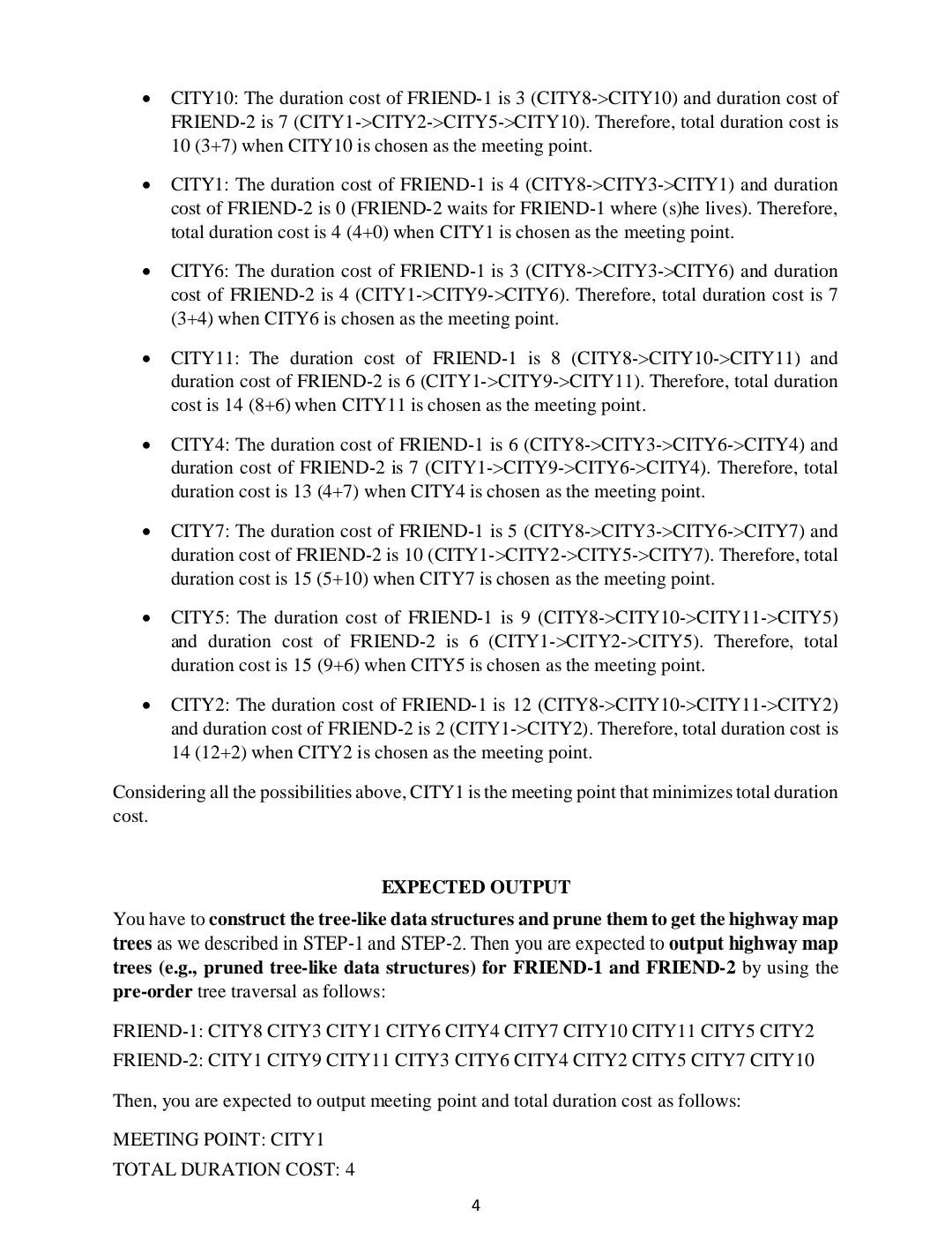
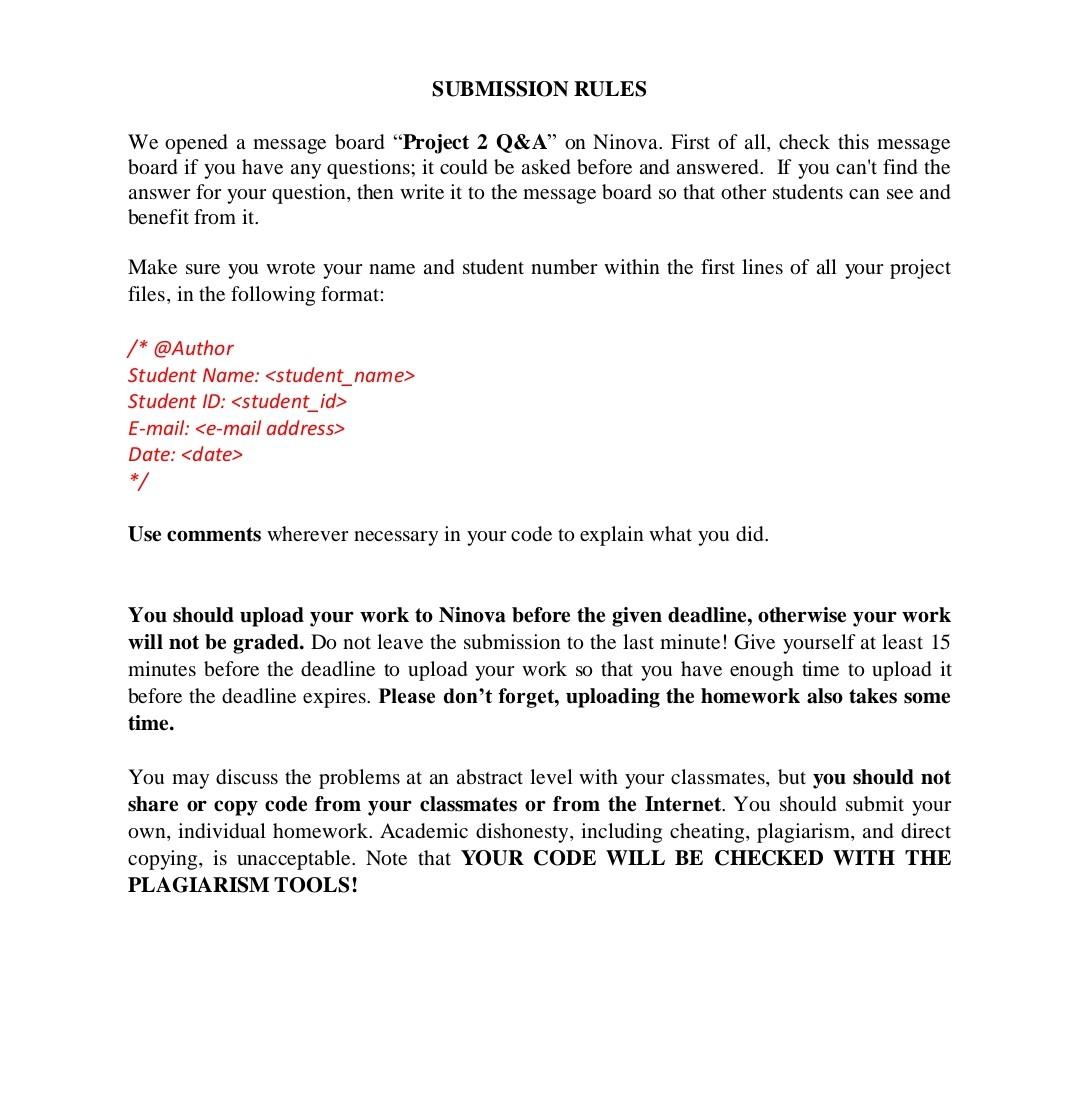
Kindly help me out and do it quickly. Thank you!
PROBLEM DEFINITION Two friends are living in different cities. They both have a car and want to meet at a point such that total duration of their journey is minimized. They both have a highway duration map that shows which cities may be reached from which cities in what a duration. For each friend, the highway duration map is given in a file with the following format: SOURCE_CITY DESTINATION_CITY DURATION SOURCE_CITY DESTINATION_CITY DURATION RUNNING THE PROGRAM The names of the highway duration map files are supplied via command line as follows: ./blg223e_hw2 name_of_file_for_friend_1 name_of_file_for_friend_2 For example, if the name_of_file_for_friend_1 is mapl_friend1.txt and name_of_file_for_friend_2 is map1_friend2.txt, then the program will be run with the following command ./blg223e_hw2 map1_friend1.txt mapl_friend2.txt and if the name_of_file_for_friend_1 is map2_friend1.txt and name_of_file_for_friend_2 is map2_friend2.txt, then the program will be run with the following command ./blg223e_hw2 map2_friend1.txt map2_friend2.txt The requested steps for the homework is shown in the following sections with an example use case. 1 STEP-1: USING FILES FOR TREE-LIKE DATA STRUCTURE CONSTRUCTION The first step is to construct two tree-like data structures from the highway duration map files. You can assume that the highway duration map records are links of a binary tree-like data structure: the parent node is the source city and the child node is the destination city for a one- way highway link. Figure 1 and Figure 2 show examples of highway duration map files for FRIEND-1 and FRIEND-2 alongside of the highway map tree-like data structures constructed using the lines in these files. We call the data structure as tree-like since there may be more than one paths from a node to another node in the data structure. You will prune all the excess links in the STEP-2 of this homework to make it a tree. Please note that, the duration maps of two friends may contain different durations for the same city pair (one friend may drive faster while the other one drives slower). Therefore, construct the tree-like data structures based on the given map files separately. HIGHWAY DURATION MAP FILE OF FRIEND 1 WHO LIVES IN CITYS (ROOT OF THE TREE) INTER-ATY HIGHWAY MAP TREE-UKE DATA STRUCTURE OF THE FRIEND 1 WHO LIVES IN CITYS (ROOT OF THE TREE) CITY8 CITY8 CITY3 CITY8 CITY10 3 CITY3 CITY1 CITY3 CITY6 2 1 CITY3 CITY10 CITY10 CITY11 5 CITY1 CITY4 3 CITY1 CITY6 CITY11 CITY6 CITY4 CITY6 CITYZ 3 2 3 4 CITY11 CITY5 CITY11 CITY2 1 4 CITY4 CITY7 CITYS CITY2 Figure 1: City Highway Map File of FRIEND-1 (LEFT) and the City Highway Map Tree-like data structure constructed from the file (RIGHT). HIGHWAY DURATION MAP FILE OF FRIEND 2 WHO LIVES IN CITY1 (ROOT OF THE TREE) INTER-ATY HIGHWAY MAP TREE-LIKE DATA STRUCTURE OF THE FRIEND 2 WHO LIVES IN CITY1 (ROOT OF THE TREE) CITY1 CITY1 CITY1 CITY9 CITY2 1 2 2 CITY9 CITY11 5 CITY9 CITY6 3 CITY9 CITY2 CITY2 CITY6 CITY2 CITYS 4 4 3 CITY11 CITY3 3 CITY11 CITY6 CITYS CITY CITY4 3 3 4 CITY CITY 4 CITY5 CITY10 1 CITY3 CITY4 CITY CITY10 Figure 2: City Highway Map File of FRIEND-2 (LEFT) and the City Highway Map Tree-like data structure constructed from the file (RIGHT). 2 STEP-2: PRUNING THE TREE-LIKE DATA STRUCTURES In the constructed tree-like data structure, there may be more than one paths with different duration costs from the root of the tree to a city. Consider Figure 1 in which there are two paths between CITY8 to CITY 4: 1) CITY8-CITY3->CITY1->CITY4 which has a duration cost of 7 (2+2+3) 2) CITY8->CITY3->CITY6->CITY4 which has a duration cost of 6 (2+1+3) Therefore, the link between CITY1 and CITY4 is an excess link and must be pruned. Similarly, the link between CITY2 and CITY6 is an excess link in Figure 2 and must be pruned. Figure 3 shows the inter-city highway map trees of FRIEND-1 and FRIEND-2 which are pruned tree-like data structures of FRIEND-1 and FRIEND-2. INTER-CITY HIGHWAY MAP TREE OF THE FRIEND 1 PRUNED TREE-LIKE DATA STRUCTURE OF FRIEND 1) INTER-CITY HIGHWAY MAP TREE OF THE FRIEND 2 PRUNED TREE-LIKE DATA STRUCTURE OF FRIEND 2) CITYS CITY1 CITY3 CITY10 CITY9 CITY2 5 5 3 CITY1 CITY6 CITY11 CITY11 CITY6 CITYS 3 2 4 3 4 CITY4 CITYZ CITY5 CITY2 CITY3 CITY4 CITY7 CITY10 Figure 3: Highway Map Tree for FRIEND-1 (LEFT) and FRIEND-2 (RIGHT) STEP-3: FINDING THE MEETING POINT AND MINIMUM DURATION You have to search for the meeting point that minimizes the total journey duration by exploring each possible meeting point. The total duration cost is the sum of the duration cost of for FRIEND-1 to the meeting point and the duration cost of FRIEND-2 to the meeting point. For example, consider all possible meeting points and their total costs, taking each node of the tree for FRIEND-1 as meeting point level by level: CITY8: The duration cost of FRIEND-1 is 0 (FRIEND-1 waits for FRIEND-2 where (s)he lives) and duration cost of FRIEND-2 is INFINITE (there is no path from CITY1 to CITY8 in the tree of FRIEND-2). Therefore, it is not possible to meet at CITY8. CITY3: The duration cost of FRIEND-1 is 2 (CITY8->CITY3) and duration cost of FRIEND-2 is 9 (CITY1->CITY9->CITY11->CITY3). Therefore, total duration cost is 11 (2+9) when CITY3 is chosen as the meeting point. 3 . CITY10: The duration cost of FRIEND-1 is 3 (CITY8->CITY10) and duration cost of FRIEND-2 is 7 (CITY1->CITY2->CITY5->CITY10). Therefore, total duration cost is 10 (3+7) when CITY 10 is chosen as the meeting point. . CITY1: The duration cost of FRIEND-1 is 4 (CITY8->CITY3->CITY1) and duration cost of FRIEND-2 is 0 (FRIEND-2 waits for FRIEND-1 where (s)he lives). Therefore, total duration cost is 4 (4+0) when CITY1 is chosen as the meeting point. CITY6: The duration cost of FRIEND-1 is 3 (CITY8->CITY3->CITY6) and duration cost of FRIEND-2 is 4 (CITY 1->CITY9->CITY6). Therefore, total duration cost is 7 (3+4) when CITY6 is chosen as the meeting point. . CITY11: The duration cost of FRIEND-1 is 8 (CITY8->CITY10->CITY11) and duration cost of FRIEND-2 is 6 (CITY 1->CITY9->CITY11). Therefore, total duration cost is 14 (8+6) when CITY11 is chosen as the meeting point. . CITY4: The duration cost of FRIEND-1 is 6 (CITY8->CITY3->CITY6->CITY4) and duration cost of FRIEND-2 is 7 (CITY1->CITY9->CITY6->CITY4). Therefore, total duration cost is 13 (4+7) when CITY4 is chosen as the meeting point. . CITY7: The duration cost of FRIEND-1 is 5 (CITY8->CITY3->CITY6->CITY7) and duration cost of FRIEND-2 is 10 (CITY1->CITY2->CITY5->CITY7). Therefore, total duration cost is 15 (5+10) when CITY7 is chosen as the meeting point. CITY5: The duration cost of FRIEND-1 is 9 (CITY8->CITY10->CITY11->CITY5) and duration cost of FRIEND-2 is 6 (CITY 1->CITY2->CITY5). Therefore, total duration cost is 15 (9+6) when CITY5 is chosen as the meeting point. . CITY2: The duration cost of FRIEND-1 is 12 (CITY8->CITY 10->CITY11->CITY2) and duration cost of FRIEND-2 is 2 (CITY1->CITY2). Therefore, total duration cost is 14 (12+2) when CITY2 is chosen as the meeting point. Considering all the possibilities above, CITY1 is the meeting point that minimizes total duration cost. EXPECTED OUTPUT You have to construct the tree-like data structures and prune them to get the highway map trees as we described in STEP-1 and STEP-2. Then you are expected to output highway map trees (e.g., pruned tree-like data structures) for FRIEND-1 and FRIEND-2 by using the pre-order tree traversal as follows: FRIEND-1: CITY CITY3 CITY1 CITY CITY4 CITY7 CITY 10 CITY11 CITY5 CITY2 FRIEND-2: CITY1 CITY9 CITY11 CITY3 CITY CITY4 CITY2 CITY5 CITY7 CITY 10 Then, you are expected to output meeting point and total duration cost as follows: MEETING POINT: CITY1 TOTAL DURATION COST: 4 4 SUBMISSION RULES We opened a message board Project 2 Q&A" on Ninova. First of all, check this message board if you have any questions; it could be asked before and answered. If you can't find the answer for your question, then write it to the message board so that other students can see and benefit from it. Make sure you wrote your name and student number within the first lines of all your project files, in the following format: /* @Author Student Name:Step by Step Solution
There are 3 Steps involved in it
Step: 1

Get Instant Access to Expert-Tailored Solutions
See step-by-step solutions with expert insights and AI powered tools for academic success
Step: 2

Step: 3

Ace Your Homework with AI
Get the answers you need in no time with our AI-driven, step-by-step assistance
Get Started


